How to make your online reputation management strategy effective
Did you know that 84% of shoppers read reviews prior to purchasing? This means that what people say about your brand online can significantly impact your bottom line. Therefore, it should be in your best interest to have an effective online reputation management strategy in place to monitor your brand perception.
In the following article, we’re going to tell you how to create an effective reputation management strategy and share with you a few practical tips on online reputation marketing.
What is an online reputation management strategy?
Let’s start off with a definition.
An online reputation management strategy is about putting in place tactics that help businesses create a positive brand image. This entails elements like tracking brand mentions, addressing customer concerns, and having a crisis management process in place for various potentially PR-harming scenarios.
If you get your reputation management strategy right, you can expect a boost in sales, lower churn, and higher customer loyalty.
How to create your online reputation management strategy
With the definition covered, let us now discuss the actions you should take to create an effective reputation management strategy.
Understand your current online reputation
Before you come up with any action plan, you need to know what your brand’s general sentiment is on day one.
As far as opinions published on websites are concerned, the easiest way to start off is to enter your brand name into Google and check what comes up in the top results.

Source: Google
The first page results are dominated by content owned by Nike, which might not always be the case; therefore it’s worth continuously monitoring the results.
The same goes for other channels, like social media. However, as you can imagine, perusing a high volume of reviews, comments, and content manually is virtually impossible. The most effective way to gain an understanding of what people think of you is by using an online reputation management tool like SentiOne. For instance, here’s an example of the sentiment share for Nike between January 19th and February 17th, 2021:
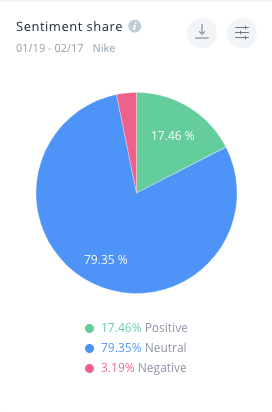
As you can see, only 3.19% of the opinions were negative, with an impressive 17.46% of people speaking highly of the brand. Knowing the proportions between good and bad opinions will help establish the main reputation-related goals, as discussed below.
Create a list of top challenges and your objectives
Based on your findings, you need to:
- Prioritize the issues you’d like to address or avoid in the future. Check the volume or reputational impact to eliminate the most recurring events.
- Identify the channels you need to keep an eye out for specifically. For example, here’s a screenshot for Mailchimp, which indicates that nearly 92% of their brand mentions between January 6th and February 4th, 2021 appeared on Twitter.
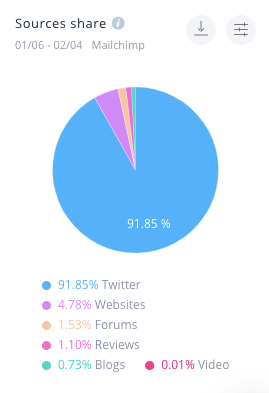
- Define your online reputation goals, namely, which areas you’d like to focus on the most in your brand management. For example, let’s assume that your sentiment analysis revealed that you have a 15% share of negative opinions. You’ve also noticed that you struggle to notice and respond to bad reviews on social media on the same day they were posted. Ask yourself: what steps can you take to improve the situation? Before deciding on lowering the negative comment share drastically to, say, 5% within two months, you must evaluate whether it’s feasible given your social media moderation team size and other ORM resources.
Make sure your online reputation management strategy is both proactive and reactive
A successful online reputation management strategy needs to be both proactive and reactive in nature.
What do we mean by ‘proactivity’?
Being proactive might indicate investing in data analytics to foresee certain behaviors, reactions, or spot potential problems and risks. It goes beyond analyzing your online reputation. You need to take a step back and check whether there aren’t any issues with your website usability. Additionally, you need to revisit your pricing to ensure it stays competitive against other players on the market, etc.
What does ‘reactivity’ entail?
Respectively, being reactive means you know how to react once a crisis scenario does take place. Make sure that your online reputation management strategy foresees how you can recognize an unrolling crisis before it gets out of control. This means training your team to spot issues and knowing when to scale them to management.
That said, it is crucial that you set up alerts for your brand name and any crisis-related phrases. Search for an online reputation management tool that allows you to react quickly, right from their platform. The last thing you need is to jump between tools when a problem unfolds!
Find articles that mention you
Search for high traffic articles that mention your brand or product and make sure that the information included is up to date. For example, let’s assume there’s a popular article featuring your product which was published last year. However, in the meantime, you’ve changed your prices, which means you’d like the article to reflect that.
Let’s assume that marketing software Mailchimp has changed its prices, with the internet full of listings that feature the old pricing scheme. By entering ‘Mailchimp’ into the SentiOne platform, we’re able to identify all articles that mentioned the brand within the last year.
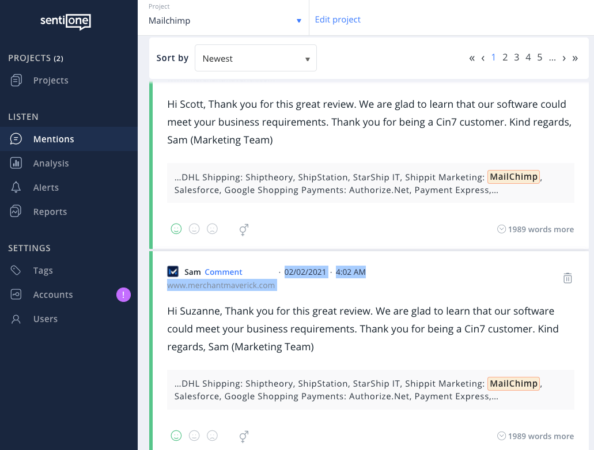
Here’s an example of one of the articles that features the prices:
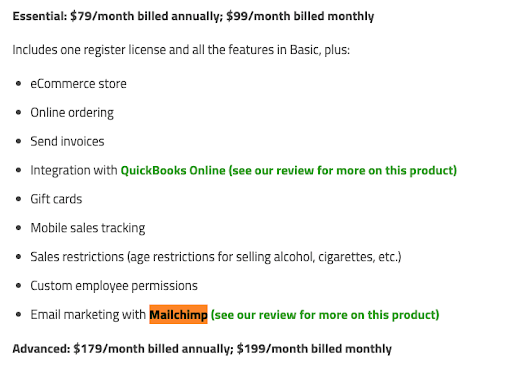
Assuming that these prices are outdated, Mailchimp’s brand manager might wish to contact the blog author and ask them to change it. However, before spending the time on finding the author’s email address and reaching out, it’s worth checking the article’s’ traffic volume with a tool like KeySearch. The more hits a site gets, the more urgently the pricing information should be changed.
Create content around popular brand terms
Taking the Mailchimp example further, if we enter the phrase into Google, we will see that the “Mailchimp vs Drip” frequently pops up. It’s in the brand’s best interest to ensure that the number one result is written by them, and their competition.
The search results on the screen below should be a source of concern for Mailchimp – no article has been written by them, with Drip owning the #1 search result.
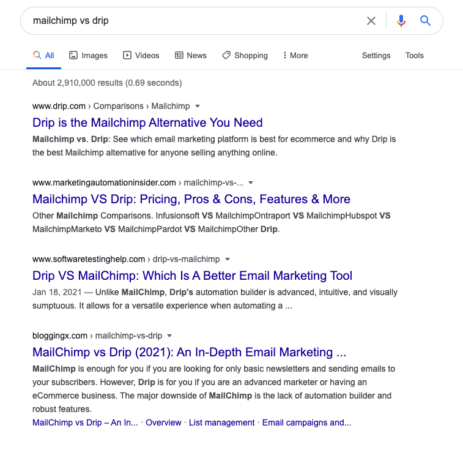
Ask your happy customers for positive reviews
Have you run an NPS campaign recently, or maybe resolved an issue that made a customer extremely happy? Identify your promoters and ask them to write you a positive review. A lot of prospects turn to online reviews before they commit to a purchase. That’s why you should treat positive review collection as a continuous process, not a one-off project.
You can automate this process if you use a chatbot. If your respondent gives you a high score, automate a question like “if we reached out, would you be willing to provide us with a testimonial/create a case study?” If they say “yes”, make sure to reach out immediately.
With all of the above in mind, let’s proceed to another pillar of brand reputation – online reputation marketing.
Online reputation marketing as part of the reputation management strategy
Online reputation marketing is the process of collecting positive reviews and testimonials and turning them into marketing collateral to be used in promotional campaigns. To put it simply, it’s about treating your brand reputation as your main promotional asset.
Here are a few tips we recommend implementing:
Online reputation marketing tactics
- Include positive reviews in your email campaigns. In your online reputation management tool, filter the positive opinions and select those that would fit your product marketing mailings or newsletters.
- Display positive reviews on your website. When entering your website, visitors frequently look for testimonials. Make sure to include them in a place with significant exposure.
- Share them on your social media channels. People like hearing good news – whenever you get a positive review share it with your audience across all your social media channels.
- Link to different review sites. Some people don’t trust customer opinions on owned media – which is why it’s worth directing them to independent opinion sites. This will give your company more credibility and build trust.
Reputation management strategy – concluding thoughts
Having an effective online reputation management strategy in place is crucial for any brand with a digital presence. It should be built around two key pillars, i.e., a variety of proactive and reactive measures. This includes: monitoring brand mentions, responding to customer queries and concerns, and having clearly-defined PR crisis management procedures.
You should also make the most of your positive opinions and leverage them in your marketing collateral. Featuring good reviews on your site or on social media can help convince hesitant prospects to trust your brand.
To make sure that your company maintains a healthy positive-to-negative sentiment ratio, we recommend using social media listening tools like SentiOne. It lets you set alerts for any crisis-related keywords, automatically detect any anomalies (such as a sudden spike in brand mentions), and analyze all of your online brand mentions at any given time and source.
Sounds interesting? Reach out for a free demo!



